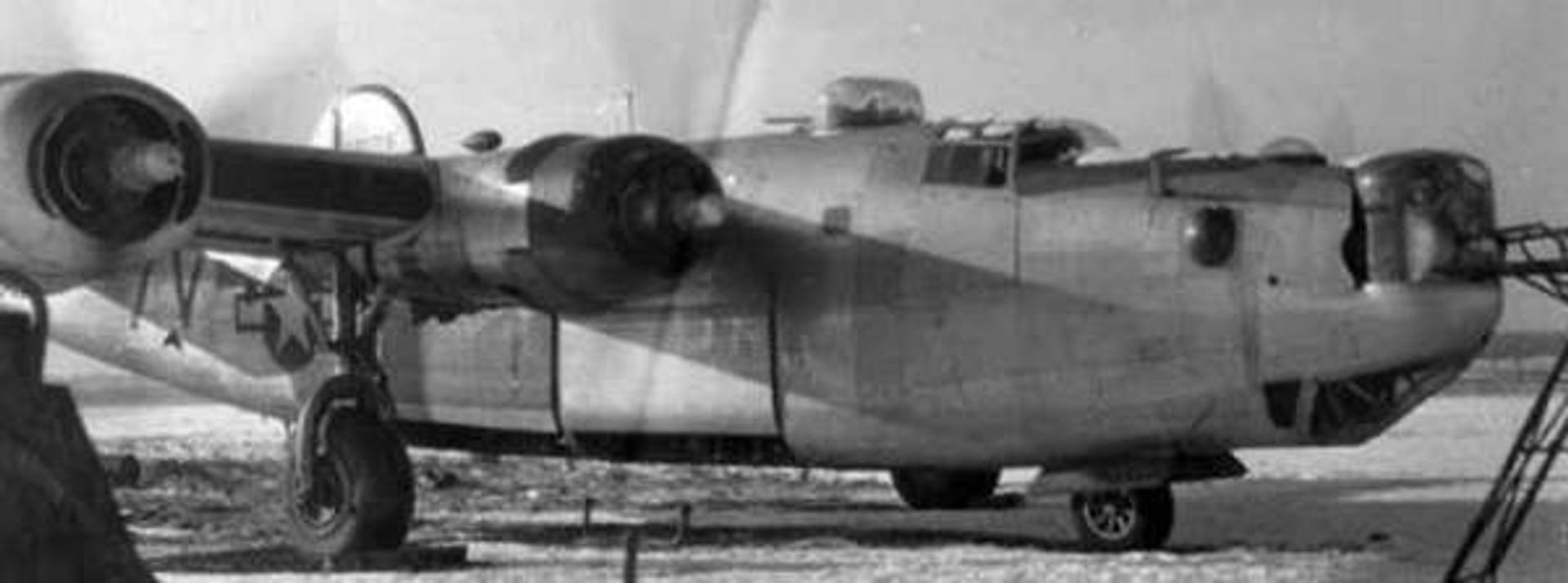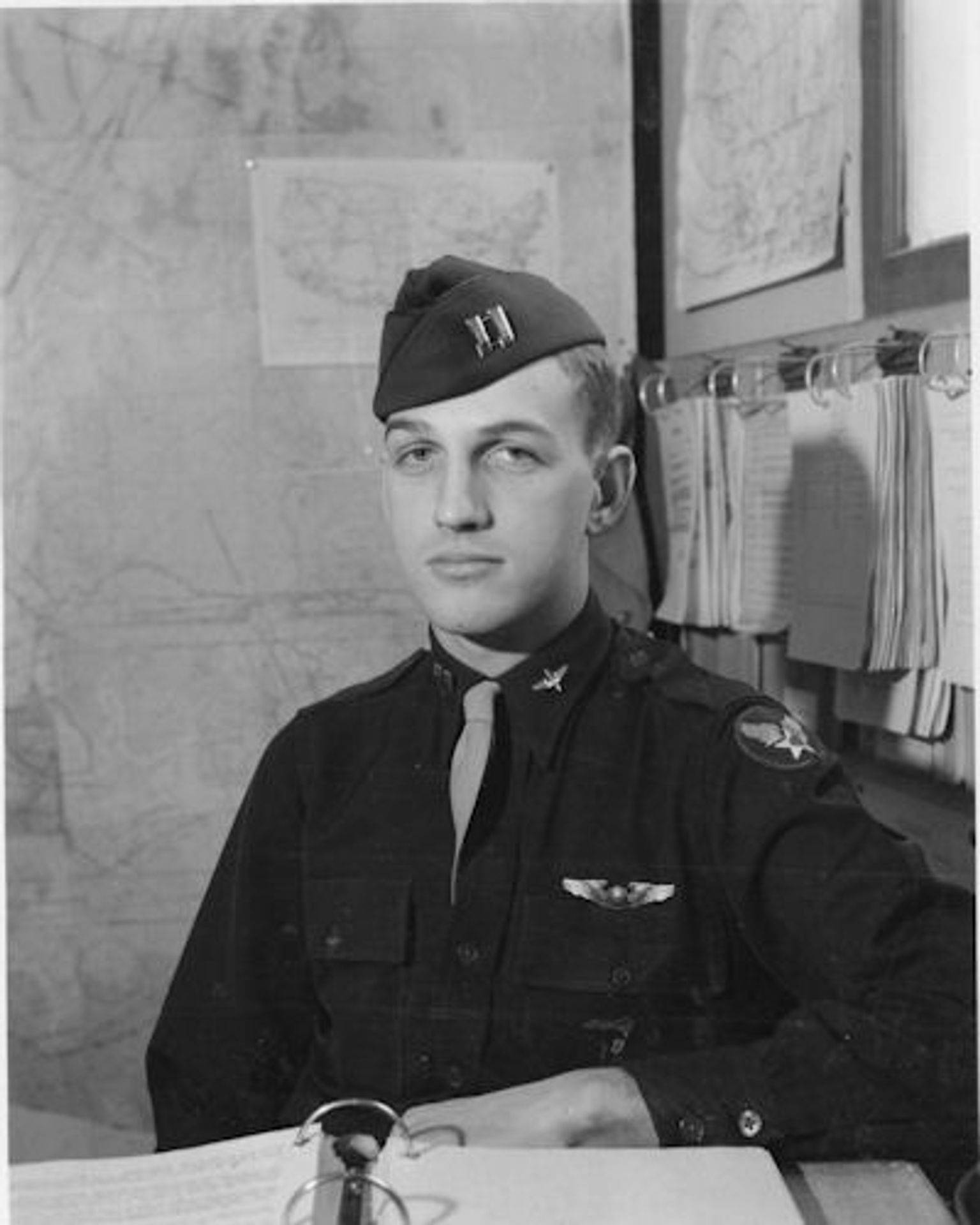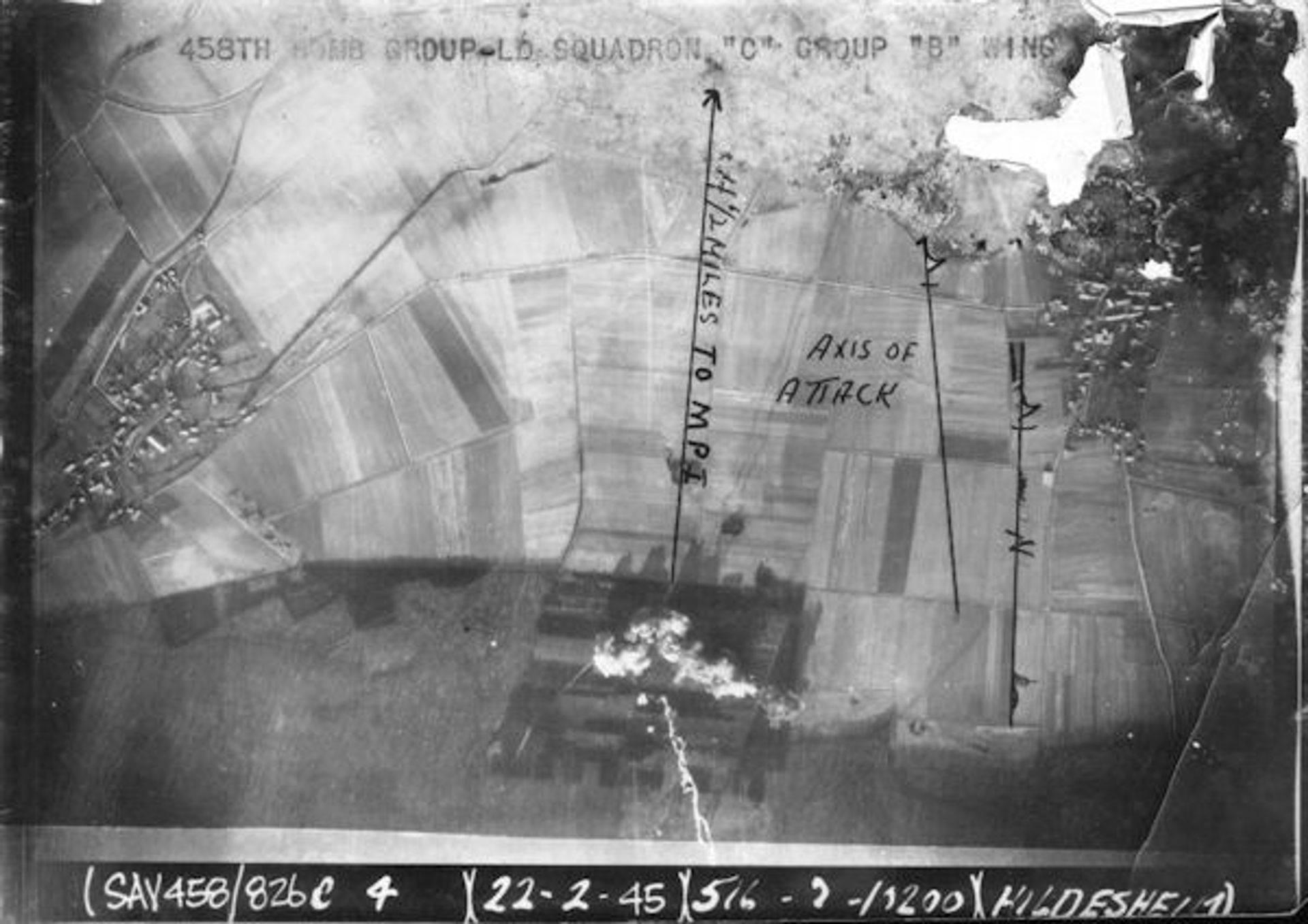Szarko Crew – Assigned 752nd Squadron – November 9, 1944

(Photo: Mike Paolella)
Shot down February 22, 1945 – MACR 12659
| Rank | Name | Serial # | Pos | Date | Status | Comments |
|---|---|---|---|---|---|---|
| 2Lt | Joseph E Szarko | 0816001 | Pilot | 22-Feb-45 | KIA | Providence, RI |
| 2Lt | Casimer P Lenart | 0828009 | Co-pilot | 22-Feb-45 | KIA | Chicago, IL |
| 2Lt | Jacques Victor | 02064461 | Navigator | 15-May-45 | UNK | Asst 754 Sqdn Bombardier |
| 2Lt | Vincent P Schlipf | 02063481 | Bombardier | 22-Feb-45 | KIA | Lorraine American Cemetery |
| S/Sgt | Edward C Herndon | 34681404 | Radio Operator | 22-Feb-45 | KIA | Lorraine American Cemetery |
| S/Sgt | Sterlin W Parkinson | 14056683 | Flight Engineer | 22-Feb-45 | KIA | Lorraine American Cemetery |
| Sgt | Robert M Dodgon | 34573258 | Armorer-Gunner | 22-Feb-45 | KIA | Marietta, GA |
| Sgt | Raymond J Zlotorzynski | 36896451 | Aerial Gunner | 22-Feb-45 | KIA | Lorraine American Cemetery |
| Sgt | Paul L Macy | 35902661 | Aerial Gunner | 22-Feb-45 | KIA | Lafayette, IN |
| Sgt | Michael A Paolella | 35926411 | Aerial Gunner | 22-Feb-45 | KIA | Lorraine American Cemetery |
Lt. Szarko and crew were assigned to the 752nd Squadron in early November 1944. They began flying missions one month later after their in-theater indoctrination period. Their second mission on Christmas Eve was in part of the Eighth Air Force’s “Maximum Effort” in which every flyable aircraft was put into the air. The 458th put up 56 aircraft on this date, only three of which turned back. The crew flew three consecutive missions to Magdeburg in February 1945. Their last mission came on February 22, 1945 when, the formation flying low at 10,000 feet, Szarko’s plane received a direct hit from flak, tearing off a wing. All ten men aboard were killed.
Lt. Jacques Victor, bombardier on Szarko’s crew, did not fly on February 22, 1945. He had been transferred to the 755th Squadron on February 7th to become a lead bombardier. The last time Lt. Victor is mentioned in group records he was sent on leave in mid-April, suggesting he was about half-way to completing a combat tour. On this last mission, Szarko’s crew carried an RCM (Radar Counter Measures) Operator, S/Sgt George J. Douromes, who had been assigned in September 1944 as a gunner on 2Lt Clyde D. Simpson’s crew. S/Sgt Douromes had attended RCM school in November 1944 and had been flying with various crews, operating the radar countermeasures equipment. Lt. Simpson and his crew were flying behind Lt. Szarko on February 22nd and witnessed their plane go down.
MACR 12659
“A/C was seen to suffer a direct flak hit between #3 & 4 engines. The landing gear fell down, the right wing flew off, the A/C went into a spin and crashed in woods at approximately 5056-0947. One ‘chute was observed to open very close to the ground.”
Missions
| Date | Target | 458th Msn | Pilot Msn | Serial | RCL | Sqdn | A/C Msn | A/C Name | Comments |
|---|---|---|---|---|---|---|---|---|---|
| 22-Nov-44 | Non-Ops Msn | -- | ACC | 42-100425 | O | 7V | -- | The Bird | Taxiing Accident Sta 123 |
| 04-Dec-44 | BEBRA | 152 | 1 | 42-95179 | X | 7V | 63 | HERE I GO AGAIN | |
| 24-Dec-44 | SCHONECKEN | 157 | 2 | 42-52457 | Q | 7V | 72 | FINAL APPROACH | |
| 30-Dec-44 | NEUWIED | 161 | 3 | 42-100407 | R | 7V | 61 | LITTLE LAMBSY DIVEY | |
| 01-Jan-45 | KOBLENZ | 163 | 4 | 42-51110 | M | 7V | 61 | TOP O' THE MARK | LANDED IN BRUSSELLS |
| 08-Jan-45 | STADTKYLL | 167 | ABT | 42-95165 | L | 7V | -- | COOKIE | #2 ENG FEATHERED |
| 14-Jan-45 | HALLENDORF | 170 | 5 | 42-51561 | G | 7V | 2 | LUCKY 13 | |
| 17-Jan-45 | HARBURG | 172 | 6 | 42-51270 | A | 7V | 1 | MY BUNNIE II | |
| 03-Feb-45 | MAGDEBURG | 177 | 7 | 42-52457 | Q | 7V | 84 | FINAL APPROACH | |
| 06-Feb-45 | MAGDEBURG | 178 | 8 | 41-29352 | K | 7V | 70 | WOLVE'S LAIR | |
| 15-Feb-45 | MAGDEBURG | 182 | 9 | 42-51110 | M | 7V | 70 | TOP O' THE MARK | |
| 16-Feb-45 | OSNABRUCK | 183 | MSHL | -- | -- | -- | -- | MARSHALING CHIEF | |
| 17-Feb-45 | ASCHAFFENBURG | REC | -- | 42-50502 | E | 7V | -- | LARRUPIN' LINDA | RECALL - WEATHER |
| 22-Feb-45 | PEINE-HILDESHEIM | 186 | 10 | 42-51215 | T | 7V | 24 | UNKNOWN 024 | SHOT DOWN, FLAK |
Excerpt from Liberators Over Norwich

On 22 February the combined might of the USAAF and RAF Bomber Commands based in Britain and Italy, and consisting of well over 2,000 heavy and medium aircraft, were directed against the Nazi communications network in a two-day operation code-named Clarion. The 2BD’s contribution involved 452 aircraft, thirty-four of which came from Horsham. Marshalling yards concentrated in an inverted geographic triangle, with Hannover and Magdeburg as its baseline, formed the Division’s targets. Hildesheim and Peine lay east of Hannover, and separate formations of eighteen and sixteen were respectively allocated for the twin assault.
A feature of the day’s operations was the low bombing altitude of 10,000 ft announced at briefing. This was a matter that would not have impressed the crews, because although the Luftwaffe was basically a spent force, this state did not apply to the provision of flak batteries throughout the Reich. In fact, the enemy gunners would be directly or indirectly involved in the extremely low tally of MIA bombers (7) out of 1,372 completing the mission. However, a gut feeling that the low altitude approach was tempting fate would come true in two instances within the group ranks.
Bad Hersfeld, around 30 miles due west of Eisenach, was not noted for possessing real industrial output; on the other hand, flak dispositions were not exclusively committed to the defence of cities or towns involved in key war production. B-24H-30-DT 42-51215 7V T, flown by Lt. Joseph E Szarko, was stationed at the rear of the formation. This crew had completed ten missions, while the RCM operator [S/Sgt George Douromes, pictured below] was on his sixteenth. As the bombers were passing Hersfeld a burst of ranging flak blossomed out, followed by a full pattern. The first shell exploded squarely inside Lt. Szarko’s bomb bay and the airframe erupted, one wing shearing off in a fascinating slow motion manner.
A single parachute was observed to issue briefly from one waist window before it and its hapless wearer were drawn back into the mass of flames that was now a cruel substitute for a proud, multi-ton aircraft. No other member among the ten on board was seen to emerge, and their deaths within or free of the plunging wreckage were subsequently confirmed. The dreadfully effective destruction of Lt. Szarko’s bomber could have been easily paralleled by the accompanying group aircraft of Lt. Merlin E Tebbs, flying in charge of B-24H-30-DT 42-51206 7V S The Pied Piper. One wing tip on the doomed bomber smashed into his B-24 and excised one of the rudders, something that could easily have thrown it out of control.
In spite of this crippling degree of damage Tebbs and his co-pilot managed to maintain sufficient manoeuvrability to hold station and finally divert into Woodbridge emergency airfield; here the necessary repairs were made and the B-24 returned to combat duty.
Liberators Over Norwich, Pg. 231-2

B-24H-30-DT 42-51215 7V T


Previously assigned to the 755th Squadron (J3), Szarko and crew were flying this ship when a direct burst of flak took off their right wing.
(Photos: Brendan Wood & Mike Paolella
B-24H-30-DT 42-51206 7V S The Pied Piper

752nd Squadron Records
“The operational history of [the] 752nd squadron operations for February was marred by the loss of one crew — 2nd Lt. Joseph E. Szarko’s. Nine regular members of his crew and one RCM Operator were lost on this mission, 22 February 1945. Most of the crew had about 10 missions to their credit. The RCM [Sgt Douromes] had 16. At the time Lt. Szarko’s crew went MIA, the wing of his ship came off and tore the rudder off 1st Lt. Merlin E. Tebbs’ ship. Lt. Tebbs, who was flying ship No. 42-51206, had much difficulty therefore in bringing the kite home, but home it came.”
(Photo: Alice Burman)
February 22, 1945

Major Charles H. Booth, 458th Bomb Group Operations Officer was leading the group to the marshalling yards at Peine-Hildesheim on February 22, 1945. The following is a letter that he sent to one of his 755th Squadron comrades in April 2005.
I have sent you a copy of the “Command Pilot Condemnation” for our 22 February 1945 raid. I want to thank you for your record of that mission. It was a crazy mission! From my point of view as the command pilot – the target was directly in front of us, the weather was perfect, and we probably would not have needed the bomb sight to hit the target! A B-17 group was coming from the right about 2,000 feet below us. They were hitting the target and I could see rail cars flying into the air. I was afraid that we may end up dropping bombs on the B-17’s. All at once, someone over the radio said, “Bombs away!” I could not believe it, because the target was still “dead ahead”. I announced, “Hold all!”, but it was too late! I called the bombardier on the inter-phone and asked, “What the hell happened?” He had made a mistake and later at interrogation he took the blame. It was too bad – a wasted mission and a costly one. I agree with you, let’s get back to altitude! We were actually at around 5,000 feet as I recall!

